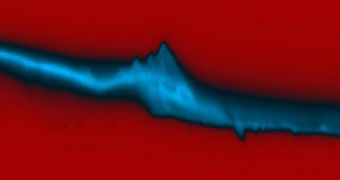A team of researchers from the UK states that Saturn's F ring is the most dynamic of all other rings, since it can change its features either in only a few hours or in a couple of years, probably due to large scale collisions taking place inside it. If this is truly the case, then the further study of the processes taking place inside it could help astronomers understand the key interactions taking place during the early planet formation stages.
"Saturn's F ring is perhaps the most unusual and dynamic ring in the solar system; it has multiple structures with features changing on a variety of timescales from hours to years", said professor Carl Murray of Queen Mary, University of London, leader of the new study and part of the Cassini Imaging Team.
Data collected by the Cassini spacecraft between 2006 and 2007 shows how the collisions between the small moonlets in the core of the F ring create a series of rapidly evolving structures, the so-called 'jets'. A couple of months after reaching the Saturnian system, Cassini discovered an object known as S/2004 S 6 measuring some 5 kilometers across which may account for some of the largest features found in the F ring.
"Previous research has noted the features in the F ring and concluded that either another moon of radius about 100km must be present and scattering the particles in the ring, or a much smaller moonlet was colliding with its constituent particles. We can now say that the moonlet is the most likely explanation and even confirm the identity of one culprit", Murray said.
Saturn's Prometheus moon is continuously gravitationally interacting with the F ring and the objects in the near vicinity, thus altering their trajectories, which reveals the gravitational signature of the invisible objects embedded in the ring.
"Large scale collisions happen in Saturn's F ring almost daily - making it a unique place to study. We can now say that these collisions are responsible for the changing features we observe there", said co-author of the study Dr Sebastien Charnoz from the Universite of Paris 7 / CEA Saclay.
Additionally, Cassini revealed the presence of gravitational signatures left behind by objects as small as one kilometer across orbiting in the close vicinity of the F ring.
"This incredibly successful mission has taught us a great deal about the solar system and the processes at work in it. Understanding how small objects move within the dust rings around Saturn gives an insight into the processes that drive planetary formation, where the proto-planet collects material in its orbit through a dust plane and carves out similar grooves and tracks", said professor Keith Mason of the Science and Technology Facilities Council.

 14 DAY TRIAL //
14 DAY TRIAL //